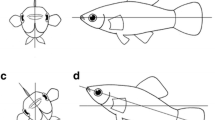Abstract
Hawaiian tree crickets are remarkably speciose and phenotypically diverse and yet we know very little about their behavior. I present the first description of courtship and mating in a member of this group. Leptogryllus elongatus Perkins inhabit the hollow fronds of giant tree ferns on the windward slope of Mauna Kea, on the Big Island of Hawaii. Unlike all other tree crickets, except for the closely related genus Thaumatogryllus, Leptogryllus lack a stridulum to produce song and have no auditory tympanum. In the absence of song, courtship in L. elongatus appears to be vibratory and tactile, in the form of tremulation and tapping of the male cerci against the body of the female. Tremulation by male L. elongatus takes the form of a rhythmic “push-up” beginning at first contact and continuing until the postcopulatory dismount. During courtship, the male maneuvers his abdomen beneath the female and the female dorsally mounts the male. As in other tree crickets, copulation results in transfer of a small spermatophore composed on a external sperm sack and a tube running inside the genitalia of the dorsally mounted female. The rate of tremulation is relatively constant from first contact until copulation. Tremulation rate decreases after spermatophore transfer but increases dramatically when the female begins to move off the male. Another key difference is the lack of metanotal gland feeding in L. elongatus. Nevertheless, L. elongatus display prolonged postcopulatory mounted courtship which delays removal of the spermatophore by the female.


Similar content being viewed by others
References
Alexander RD, Otte D (1967) The evolution of genitalia and mating behavior in crickets (Gryllidae) and other Orthoptera. Misc. Publs. Mus. Zool. Univ. Mich 133:1–62
Bailey NW, McNabb JR, Zuk M (2008) Preexisitng behavior facilitated the loss of a sexual signal in the field cricket Teleogryllus oceanicus. Behav Ecol 19:202–207
Bell, P (1979) Mate choice and mating behavior in the black horned tree cricket, Oecanthus nigricornis (Walker). M.S. thesis, University of Toronto
Belwood, JJ (1990) Anti-predator defences and ecology of neotropical forest katydids, especially the Pseudophyllinae, pp. 8–26. In W. J. Bailey and D. C. F. Rentz (eds.), The Tettigoniidae: Biology, systematics and evolution. Crawford House Press, Bathurst, Australia
Brown WD (1997) Courtship feeding in tree crickets increases insemination and female reproductive life span. Anim Behav 54:1369–1382
Brown WD (1999) Mate choice in tree crickets and their kin. Annu Rev Entomol 44:371–396
Brown WD (2011) Allocation of nuptial gifts in tree crickets changes with both male and female diet. Behav Ecol Sociobiol 65:1007–1014
Bussière L, Basit HA, Gwynne DT (2005) Preferred males are not always good providers: female choice and male investment in tree crickets. Behav Ecol 16:223–231
De Luca PA, Morris GK (1998) Courtship communication in meadow katydids: female preference for large male vibrations. Behaviour 135:777–794
Deb R, Balakrishnan R (2014) The opportunity for sampling: the ecological context of female mate choice. Behav Ecol 25:967–974
Eades, D.C., D. Otte, M.M. Cigliano and H. Braun. 2015. Orthoptera species file. Version 5.0/5.0. <http://Orthoptera.SpeciesFile.org>
Mendelson TC, Shaw KL (2005) Sexual behavior: rapid speciation in an arthropod. Nature 433:375–376
Morris GK (1980) Calling display and mating behaviour of Copiphora rhinoceros Pictet (Orthoptera: Tettigoniidae). Anim Behav 28:42–51
Morris GK, Mason AC, Wall P, Belwood JJ (1994) High ultrasonic and tremulation signals in Neotropical katydids (Orthoptera, Tettigoniidae). J Zool 233:129–163
Otte D (1989) Speciation in Hawaiian crickets. In: Otte D, Endler JA (eds) ), Speciation and its consequences. Sinauer Associates, Sunderland, Mass, pp. 482–526
Ponce-Wainer JX, Del Castillo RC (2008) Female mate choice and no detected predation risk in relation to the calling song of Oecanthus niveus (Gryllidae: Oecanthinae). Annals Entomol. Soc. Amer 101:260–265
Shaw KL (2002) Conflict between mitochondrial and nuclear DNA phylogenies of a recent species radiation: what mitochondrial DNA reveals and conceals about modes of speciation in Hawaiian crickets. Proc. Nat. Acad. Sci. USA 99:16122–16127
Stritih N, Čokl A (2012) Mating behaviour and vibratory signaling in non-hearning cave crickets reflect primitive communication of Ensifera. PLoS One 7:e47646
Stritih N, Čokl A (2014) The role of frequency in vibrational communication of Orthoptera. In: Cocroft RB et al. (eds) Studying vibrational communication, animal signals and communication 3. Springer-Verlag, Berlin Heidelberg, pp. 375–393
Walker TJ, Gurney AB (1967) The metanotal gland as a taxonomic character in Oecanthus of the unite states (Orthoptera: Gryllidae). Proc Entomol Soc Wash 69:157–161
Zimmerman, EC (1948) Insects of Hawaii, vol. 2. Bishop Museum Press, Honolulu, Hawaii
Zuk M, Rotenberry JT, Tinghitella RM (2006) Silent night: adaptive disappearance of a sexual signal in a parasitized population of field crickets. Biol Lett 2:521–524
Acknowledgments
Initial stages of this project were supported by a Sigma-Xi Grant In Aid of Research to W. B. and a Natural Science and Engineering Research Council of Canada operating grant to D. Gwynne.
Author information
Authors and Affiliations
Corresponding author
Rights and permissions
About this article
Cite this article
Brown, W.D. Mating Behavior of the Endemic Hawaiian Cricket Leptogryllus elongatus (Orthoptera: Gryllidae: Oecanthinae). J Insect Behav 29, 449–458 (2016). https://doi.org/10.1007/s10905-016-9574-0
Revised:
Accepted:
Published:
Issue Date:
DOI: https://doi.org/10.1007/s10905-016-9574-0




